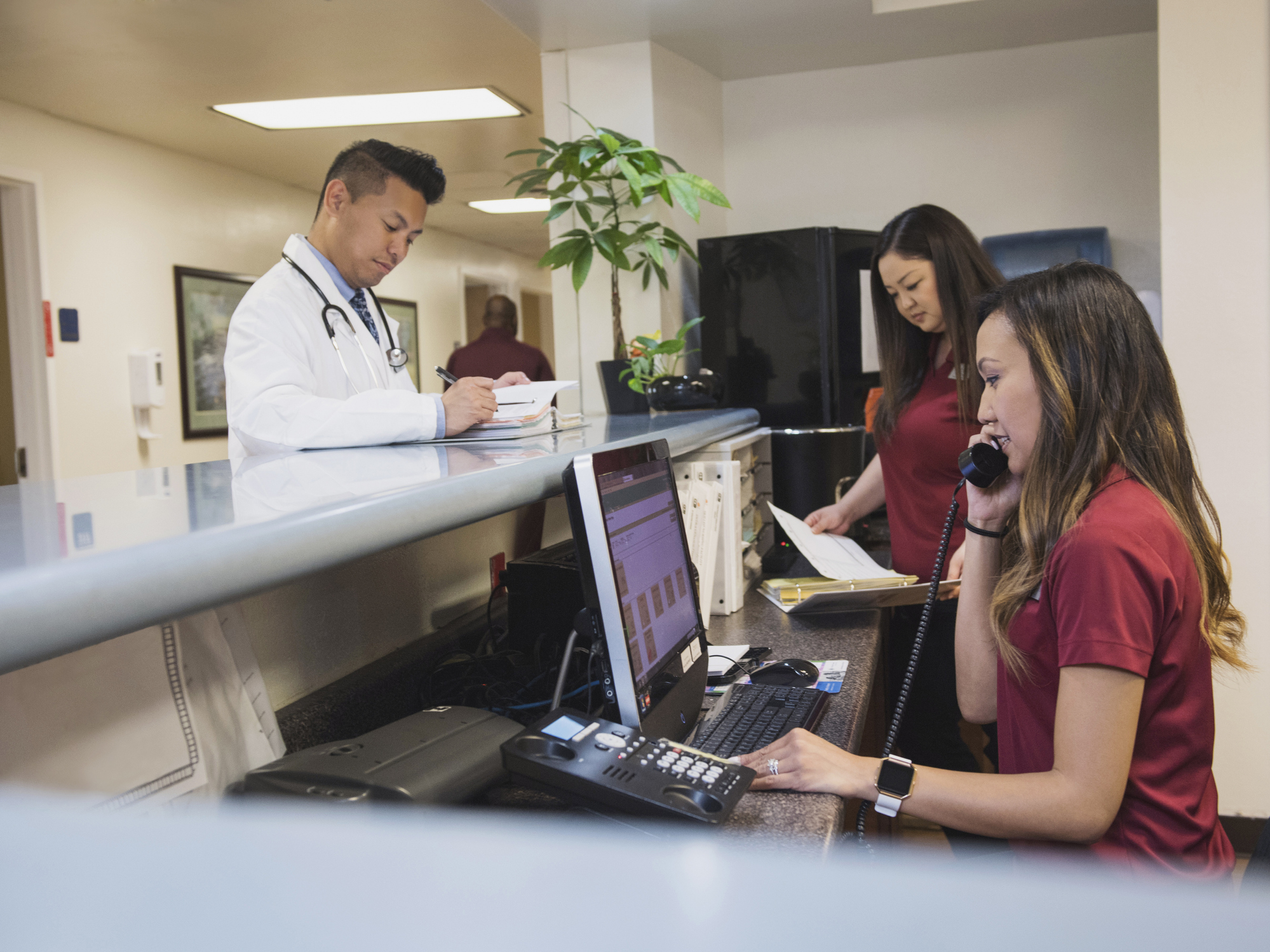Easiest Medical Schools to Get Into
Interested in medical school, but intimidated about admission requirements? Learn about the easiest medical schools to get into here.
3,700+ Nonprofit, accredited colleges analyzed

6,000+ Users connected with programs every month

300+ College and university partners

40+ Expert reviewers
Learn more about our Editorial Policy and Standards and Advertising Disclosure.
Medical school prepares students to become doctors and improve the health and lives of other people. Working in medicine is often rewarding and lucrative.
Getting into medical school is difficult. The Association of American Medical Colleges (AAMC) reports that only about 42% of applicants matriculated in 2020-2021. Many qualified applicants are rejected each year because not enough medical schools exist to meet the demand for a medical education.
Medical school is expensive and time-consuming. The AAMC reports that the average medical student graduated with around $207,000 in debt in 2020. Medical students usually finish school in about four full-time years.
New physicians receive supervised training in their medical specialty during residency, which lasts 3-8 years. Residency is often followed by a 1- to 3-year fellowship.
This guide explains what it takes to get into medical school. We also provide a ranked list of the easiest medical schools to get into to help you decide where to apply.
Easiest Medical Schools to Get Into
How We Rank Schools
University of North Dakota
- Grand Forks, ND
- 4 year
- Campus + Online
- Accredited
The University of North Dakota's School of Medicine & Health Sciences offers eight healthcare programs, including the state's only four-year MD program. The oldest university in North Dakota, UND partners with clinical facilities throughout the state where students can train after their second year.
UND accepts about 28% of medical school applicants, making it one of the easiest medical schools to get into. The university strives to offer educational opportunities for American Indian students by committing to accepting a certain percentage of qualifying applicants each year.
Prospective students must submit MCAT scores, letters of recommendation, and an experiences and attributes portfolio. The admissions department does not require a minimum MCAT score, but all applicants must have a minimum GPA of 3.0. The average accepted applicant in 2019 had a 507 MCAT score and a 3.5 GPA.
68%
$11,963
83%
$17,944
- Acceptance Rate
- 77%
- Students Enrolled
- 14,172
- Institution Type
- Public
University of Massachusetts Medical School
- Worcester, MA
- 4 year
- Campus + Online
- Accredited
The University of Massachusetts Medical School — located in Worcester — offers training in several medical disciplines, but emphasizes primary care specialties. The school offers MD and MD/Ph.D. programs to both in-state and out-of-state residents.
UMMS partners with two acute care hospitals and maintains affiliations with several community hospitals and health centers in the region. Students typically complete clinical requirements at one of these locations.
UMMS accepts 23% of applicants. All prospective students must hold a bachelor's degree from an accredited institution and submit MCAT scores and letters of recommendation. They must also complete an interview. UMMS does not set GPA or MCAT cutoffs, but the average medical student has a 3.7 GPA and an MCAT score in the 88th percentile.
3%
$25,494
N/A
$37,838
- Acceptance Rate
- N/A
- Students Enrolled
- 1,352
- Institution Type
- Public
University of Missouri-Kansas City School of Medicine
- Kansas City, MO
- 4 year
- Campus + Online
- Accredited
The University of Missouri-Kansas City offers six medical programs with 19 specialties. Students can enroll in a six-year BA/MD program or a traditional four-year MD program. These programs incorporate clinical experiences beginning in the first semester. UMKC partners with six leading hospitals to provide students with fieldwork opportunities.
Prospective BA/MD students must have a minimum GPA of 3.0 and score at least 24 on the ACT or 1160 on the SAT. MD applicants must earn an MCAT score of at least 500 to qualify. UMKC enrolls about 645 medical students and accepts about 20% of applicants.
31%
$10,660
77%
$27,521
- Acceptance Rate
- 75%
- Students Enrolled
- 15,327
- Institution Type
- Public
University of Nevada-Reno School of Medicine
- Reno, NV
- 4 year
- Campus + Online
- Accredited
The University of Nevada, Reno's School of Medicine offers a traditional MD program, a BS/MD program, and a post-baccalaureate certificate program. The school also gives students the opportunity to pursue dual degrees, including an MD/MPH, an MD/MBA, and an MD/Ph.D.
The school boasts a small community feel, maintaining a 3-to-1 student-to-faculty ratio. Students begin working in clinical environments during their first year.
In-state applicants must have a minimum GPA of 2.8 and a 497 or higher MCAT score. Out-of-state applicants must have a minimum GPA of 3.3 and an MCAT score that is 500 or higher. The school accepts about 12% of applicants.
30%
$ 5,814
80%
$22,356
- Acceptance Rate
- 85%
- Students Enrolled
- 21,791
- Institution Type
- Public
Louisiana State University Health Sciences Center
- Shreveport, LA
- 2 year
- Campus + Online
- Accredited
Established in 1969, LSU Health Shreveport was the first state school to offer medical education in Louisiana. The university remains the only medical school in north Louisiana and one of only three operating in the Bayou State.
LSU Health Shreveport offers joint Ph.D. programs with Louisiana Tech for students interested in conducting research. The college also offers 43 fully accredited residency and fellowship programs.
The college accepts roughly 20% of medical school applicants and does not use GPA or MCAT cutoffs. However, the average student has a 3.7 GPA and a 505 MCAT score.
89%
$6,196
65%
$6,196
- Acceptance Rate
- 89%
- Students Enrolled
- 8,706
- Institution Type
- Public
University of South Dakota Sanford School of Medicine
- Vermillion, SD
- 4 year
- Campus + Online
- Accredited
The University of South Dakota's Sanford School of Medicine opened in 1907 and is still the only medical school in the state.
Sanford focuses on rural family medicine to treat traditionally underserved communities and uses a unique three-pillar program schedule. Pillars one and two focus on establishing foundational knowledge of biomedical systems and beginning clinical clerkships. The final pillar gives students the opportunity to complete surgery subspecialties, internships, electives, research, and global experiences.
The school accepts 14% of applicants. Prospective students must have a minimum GPA of 3.1 and an MCAT score of at least 496.
58%
$ 6,123
80%
$11,773
- Acceptance Rate
- 99%
- Students Enrolled
- 9,868
- Institution Type
- Public
East Carolina University Brody School of Medicine
- Greenville, NC
- 4 year
- Campus + Online
- Accredited
East Carolina University's Brody School of Medicine traces its history back to 1965. Students can pursue an MPH, MD, or Ph.D. They can also enroll in a dual-degree program.
Brody's distinction track programs allow learners to study an area of interest that relates to their medical career goals. Additionally, the school's summer program gives prospective students the opportunity to see what medical school entails and prepares them for the rigorous expectations of the program.
The Brody School of Medicine accepts 13% of applicants. The average medical student has a 3.6 GPA and a 508 MCAT score.
72%
$ 4,749
82%
$17,898
- Acceptance Rate
- 90%
- Students Enrolled
- 26,785
- Institution Type
- Public
Medical College of Georgia at Augusta University
- Augusta, GA
- 4 year
- Campus + Online
- Accredited
With a history spanning nearly 200 years, the Medical College of Georgia at Augusta University was one of the first medical schools in the nation. MCG focuses on improving healthcare in Georgia, with 48% of graduates choosing to remain in the state to practice medicine after earning their degree.
With 240 students per class, MCG is currently one of the largest medical schools in the U.S. The school offers several medical degrees across 23 departments.
MCG accepts 14% of applicants. The college considers an applicant's residency, MCAT scores, GPA, and letters of recommendation. The average MCG student has a 3.8 overall GPA and an MCAT score of 511. Applicants must have a minimum GPA of 3.0 and an MCAT score of at least 496.
59%
$ 5,504
73%
$18,772
- Acceptance Rate
- 86%
- Students Enrolled
- 9,140
- Institution Type
- Public
University of Oklahoma College of Medicine
- Oklahoma City, OK
- 4 year
- Campus + Online
- Accredited
The University of Oklahoma's College of Medicine offers an MD program, a physician assistant program, and several dual-degree options. Additionally, students wishing to complement their practice with public health knowledge can complete concurrent MPH coursework.
The college uses an innovative simulation center to train students. The center allows medical students and residents to practice clinical skills on high-tech mannequins.
The OU College of Medicine accepts 15% of applicants, and more than 75% of students are Oklahoma residents. The average accepted applicant has a 3.7 GPA and an MCAT score in the 79th percentile. Applicants must have a minimum GPA of 3.0 and a minimum MCAT score of 492.
63%
$ 5,119
N/A
$19,778
- Acceptance Rate
- N/A
- Students Enrolled
- 3,389
- Institution Type
- Public
University of Nebraska Medical Center
- Omaha, NE
- 4 year
- Campus + Online
- Accredited
Medical students at the University of Nebraska Medical Center gain in-depth medical, clinical, interpersonal, and professional skills through practice-based learning. In addition to earning a traditional medical degree, students can pursue one of UNMC's MD enrichment options. These opportunities include dual-degree programs, an interdisciplinary educational track, and an honors thesis program.
UNMC accepts 11% of medical school applicants, which translates to an average incoming class of 130 students each year. The average accepted applicant has a 3.8 GPA and a 515 MCAT score.
16%
$ 9,207
N/A
$26,379
- Acceptance Rate
- N/A
- Students Enrolled
- 3,660
- Institution Type
- Public
What Are the Admission Requirements for Medical School?
Low acceptance rates make getting into medical school extremely difficult. Even the easiest medical schools to get into only admit highly qualified applicants. Getting into medical school is much more challenging than gaining admission to most other undergraduate and graduate programs.
Medical school admission requirements vary but usually include a minimum undergraduate GPA, completion of prerequisite courses, letters of recommendation, and minimum test scores. Medical schools also look for extracurricular, volunteer, research, and clinical experience.
Education
All medical school applicants need a bachelor’s degree from an accredited college, but each institution chooses its own pre-med course prerequisites. Applicants usually need one year of biology, two years of chemistry, and one year of English, according to the AAMC.
Medical school admission requirements sometimes include competency-based exams instead of specific courses. Others require lab, volunteer, or shadowing experience.
Many undergraduate students major in a biological science field to increase their chances of getting into medical school. However, medical schools consider all applicants who complete the required prerequisites equally, regardless of their major.
Extracurriculars
Applicants may improve their chances of getting into medical school by participating in extracurricular activities. Although not typically a requirement, participation in extracurricular activities can be a window into an applicant’s personality and values.
Medical schools want empathetic, ethical students with leadership, interpersonal, and communication skills. The way you choose to spend your time outside of class can help admissions committees better understand who you are and what you care about.
Extracurricular activities can also be an excellent way to get clinical, research, or volunteer experience.
Letters of Recommendation
Medical school admissions committees usually require letters of recommendation. Students should ask for letters of recommendation from undergraduate professors, pre-med advisors, or the pre-med office at their school. Choose someone who can speak to your strengths.
GPA
Medical schools require applicants to maintain a high undergraduate GPA. Schools consider overall GPA, science GPA, and non-science GPA. Each institution decides how much weight to give each type of GPA. According to the Princeton Review, medical school enrollees held an average overall GPA of 3.71 in 2017-2018.
The easiest medical schools to get into may have lower minimum GPA requirements than the more competitive institutions.
MCAT Scores
Applicants must take the Medical College Admission Test (MCAT), a standardized test that indicates their preparedness for medical school. The MCAT asks questions geared toward determining students’ scientific knowledge and analytical skills. MCAT prep books can help students study for the exam.
According to the American Medical Association, the average MCAT score for students who attended medical school in 2018-2019 was 511.2.
CASPer Test
The Computer-based Assessment for Sampling Personal Characteristics (CASPer) is a situational judgment test many medical schools use to evaluate applicants. The exam assesses traits that physicians should possess in order to be successful. These include collaboration, communication, empathy, and equity. Not all medical schools require the CASPer test.
Application
Most medical schools in the U.S. accept first-year applications through the Association of American Medical Colleges’s American Medical College Application Service (AMCAS). Using AMCAS lets students apply to multiple programs by filling out just one primary application.
After submitting a primary application, applicants also complete secondary applications for each medical school they are applying to. In these secondary applications, students can specify why they are interested in the specific schools.
AMCAS collects all of the application information students submit and passes it on to each school.
Tips for Getting Into Medical School
Get Medical Experience on Your Resume
Improve your chances of getting into medical school by gaining medical experience to put on your resume. Although not a prerequisite, getting medical experience shows admissions committees that you are serious about pursuing a career in medicine.
Participate in Research Projects
Undergraduate research experience is essential for applicants interested in a career in medical research or academic medicine. Research experience can help you differentiate yourself from applicants without it.
Volunteer
Volunteering to help others in your community demonstrates character and integrity, both important traits for those who pursue careers in medicine. Applicants can volunteer to gain experience in medical settings and determine their career goals.
Choose a Major You Will Excel In
Prospective doctors do not need to major in biological science in order to gain acceptance to medical school. Medical school admissions committees recommend students choose an undergraduate major they genuinely enjoy and can do well in. No matter what major you choose, the American Academy of Family Physicians recommends you enroll in biology, math, chemistry, and English courses.
Apply to Multiple Schools
Applying to more than one school can increase your chances of acceptance. But, make sure to only apply to medical schools where you meet the admission criteria.
Study Early and Often for the MCAT
Although medical schools consider a prospective student’s entire application, MCAT scores are critical. Familiarize yourself with everything the MCAT test will cover, and then plan a study schedule. Many students take practice tests to track their progress.
Don’t Skimp on Extracurricular Activities
Medical school admissions committees often prefer applicants with extracurricular activities on their resumes. Students who participate in a variety of activities while maintaining high GPAs demonstrate good time management skills and a strong work ethic.
Be Ready to Explain Why You Want to Be a Doctor
Students with clear, compelling explanations for why they want to become physicians can increase their chances of getting into medical school. Many programs require applicants to submit a personal statement. Try to write a unique, honest essay that the admissions committee will remember.
How Do I Choose a Medical School?
Academic Focus
Consider each medical school’s academic focus and whether it aligns with your career goals and interests. Schools may concentrate in areas like research, primary care, or specialty medicine. For example, students who want to practice emergency medicine can benefit from choosing a medical school with a strong focus on this specialty.
Admissions Criteria
Applying to medical schools where you do not meet the admissions criteria is often a waste of time, money, and effort. Research specific requirements for each institution before beginning the application process. The easiest medical schools to get into usually have less stringent admissions criteria.
Cost
Going to medical school is not cheap. According to the AAMC, medical students paid an average tuition of $33,490 for one year at an in-state, public university in 2021-2022. Attending a public medical school where you can pay in-state tuition is typically more affordable than medical school at a private or out-of-state institution.
Location
Students should consider location when choosing a medical school. Where you go to school can drastically impact your cost of tuition. For example, attending an in-state, public school is usually more affordable than attending an out-of-state or private medical school. Where you study also impacts the clinical and research experiences available to you.
Accreditation
Accreditation is a process by which schools demonstrate that they meet minimum educational standards. In the U.S., even the easiest medical schools to get into must be accredited.
Look for MD-granting medical school programs accredited by the AAMC’s Liaison Committee on Medical Education. Medical schools that offer doctor of osteopathic medicine (DO) degrees must hold accreditation from the Commission on Osteopathic College Accreditation at the American Osteopathic Association.
Frequently Asked Questions About Medical Schools
Explore More College Resources
Other Healthcare Resources
Healthcare
programs
careers






